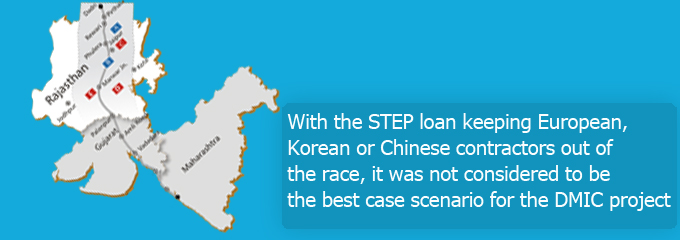|
The ambitious Delhi-Mumbai-Industrial Corridor (DMIC) project has received a major financial boost with the Japanese government agreeing to liberalise the terms of the Special Terms for Economic Partnership (STEP) loans. The STEP loan, committed by the Japanese government for Phase-1 of the DMIC project, has not been finalised so far, as the loan was opposed by the Finance Ministry for being “tied aid”.

The $4.5-billion STEP loan offered by the Japanese government is a vital source of finance for the $100 billion DMIC project, as the loan will have a tenure of 40 years and will carry an interest rate of 0.1 per cent. However, a major stumbling block in finalising the assistance was the clause stipulating that 30 per cent of the project cost would have to be spent on goods and services from Japanese countries.
The Finance Ministry was of the view that as there were not enough Japanese companies to choose from bids, the bidding process could turn out to be uncompetitive. With the STEP loan keeping European, Korean or Chinese contractors and goods out of the race, it was not considered to be the best case scenario for such a large project.
The recent decision of the government to relax the loan clause and allow to source goods and services from local companies where Japanese firms have at least 10 per cent stake, has helped the authorities to move ahead with the tendering process of the project.
The DMIC project was conceived in 2006 as a symbol of Indo-Japan strategic partnership. The 1,483 km project will run through seven states — Delhi, Uttar Pradesh, Haryana, Rajasthan, Gujarat and Maharashtra, alongside the proposed 1,483 km Delhi-Mumbai dedicated rail freight corridor.
The DMIC project is touted to be the largest infrastructure project in the world, with an estimated $90-100 billion required to set up 24 new cities in four phases by 2040. In 2008, the Delhi-Mumbai Industrial Corridor Development Corporation (DMICDC) was incorporated for developing the DMIC project, coordinating the implementation of the numerous projects and also raising finances, wherever needed.
In August 2012, the Union Cabinet approved a proposal on equity restructuring in DMICDC. The Cabinet allowed Japan Bank for International Cooperation (JBIG), a government-owned financial entity of Japan, to hold 26 per cent equity in DMICDC. The move was to increase the confidence of Japanese companies in the project and open up possibilities for long-term infrastructure lending at lower rates.
For the overall DMIC project, it is envisaged that of the total project cost, 10 per cent will come from the government while the remaining 90 per cent will come through public-private partnership (PPP).
As a means of execution, the DMIC was divided into seven cities in Phase-I. These cities were planned and then broken into non-commercial trunk infrastructure and commercial PPP projects. First, a detailed engineering of trunk infrastructure is being carried out. Only when the trunk infrastructure is set up will the private players be invited to invest in projects.
Thus, right now, the focus is on getting enough funds from the government for setting up the basic infrastructure. DMICDC's main job will be to build up the trunk infrastructure including roads, sewerage, and power lines with funding from the government. So far, the Indian government has approved an expenditure of Rs 18,500 crore for development of infrastructure in the proposed cities. This revolving fund along with the STEP loans from the Japanese government will go into the creation of trunk infrastructure.
Even with the initial government funding, the project will still require a huge backing from the private sector to materialize. DMICDC is keen to ensure that the infrastructure and services should adopt the best practices of land use planning and be comparable or exceed the standards available globally. This will require extensive planning, detailed engineering of infrastructure, environmental approvals, and land pooling procurement by the state government concerned. As new cities take anywhere around 30-40 years to break even, long-term lending at reasonable rates will play a critical role in the execution of the project.
As far as PPP projects in India go, even the well planned DMIC project is not immune to the issues that are currently faced by PPP projects. Thus, a timely execution of DMIC will go a long way in infusing confidence in the promoters of other proposed PPP projects.
|